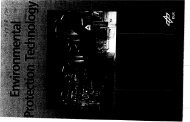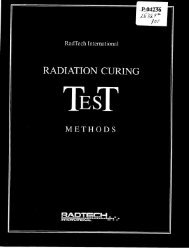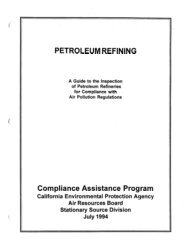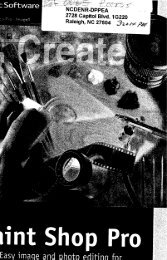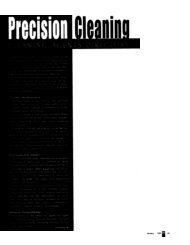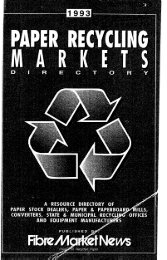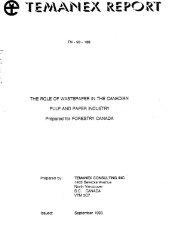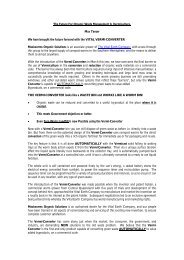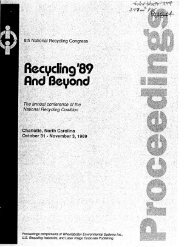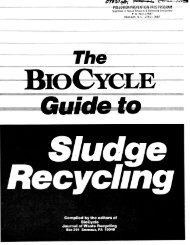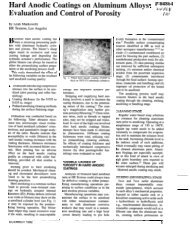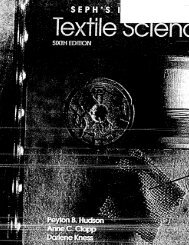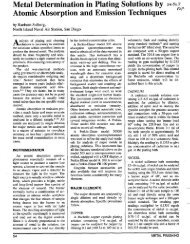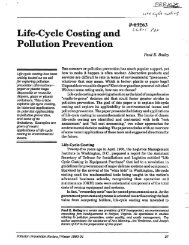Fact Sheet - Plating with Trivalent Chrome - infoHouse
Fact Sheet - Plating with Trivalent Chrome - infoHouse
Fact Sheet - Plating with Trivalent Chrome - infoHouse
Create successful ePaper yourself
Turn your PDF publications into a flip-book with our unique Google optimized e-Paper software.
Board of Public Works<br />
<strong>Plating</strong> <strong>with</strong> <strong>Trivalent</strong> <strong>Chrome</strong><br />
Much has been written in recent years about replacing environmentally hazardous hexavalent<br />
chromium electroplating solutions <strong>with</strong> trivalent ones for decorative chrome applications. Al-<br />
though hexavalent processes have been used for electroplating for over 65 years, they have<br />
serious environmental and performance problems associated <strong>with</strong> them.<br />
Hexavalent chromium is a highly toxic material as well as a suspected carcinogen. Its uses poses<br />
a danger to human health, particularly to shop personnel, as well as to the environment. Hexav-<br />
alent chromium can escape the plating line through spills, leaks, in discarded baths, rinses, and in<br />
a form of mist associated <strong>with</strong> hydrogen bubbles generated during plating operations.<br />
There are also performance deficiencies associated <strong>with</strong> hexavalent chromium use that result in<br />
many reject parts and other problems that cost a shop owner money. These deficiencies include:<br />
Poor covering power (especially around holes and slots)<br />
Burning<br />
White-washing<br />
Sensitivity to ripples in power supply<br />
Low energy efficiency: 85 to 90% of the electric power applied goes for the<br />
generation of hydrogen<br />
Hexavalent chromium wastes need to be chemically reduced to trivalent chrome in the shop’s<br />
treatment plant. This necessitates the use of expensive chemicals such as sulfur dioxide, sodium<br />
metabisulfite or sodium borohydride. Also considerable hazardous sludge is generated during<br />
the neutralization step of the treatment process due to the high chromium concentration of the<br />
plating solutions. Hazardous waste haulage and disposal costs are rising dramatically each year.<br />
Thus, it’s becoming harder to use hexavalent systems profitably.<br />
REV 11/99<br />
HAZARDOUS & TOXIC MATERIALS PROJECT BOARD OF PUBLIC WORKS<br />
City Hall 200 N. Spring Street, Room 353 * Los Angeles, California 90072 213 237-1209
Advantages Offered By <strong>Trivalent</strong> <strong>Chrome</strong> Systems<br />
<strong>Trivalent</strong> systems can save an electroplating shop money in a number of ways:<br />
1. Lower Metal Concentrations.<br />
Chromium concentrations in trivalent plating<br />
baths are typically less that 1 ounce per gallon<br />
(oz/gal). Hexavalent chromium concentrations<br />
are 15 to 40 oz/gal. Lower heavy metal concentrations<br />
mean less chrome dragout, and thus,<br />
lower waste treatment costs and less hazardous<br />
sludge generated in trivalent systems. Reducing<br />
sludge quantities also saves you money in<br />
haulage and disposal fees.<br />
2. No Reduction Step.<br />
By installing a trivalent system, you avoid the<br />
need to reduce hexavalent chrome wastes to<br />
their trivalent state. Since three pounds of<br />
sodium metabisulfite are required to reduce each<br />
pound of chromic acid, significant quantities of<br />
chemicals, as well as equipment and labor costs,<br />
are eliminated by switching to a trivalent system.<br />
3. More Parts Can Be P/aced on a Rack.<br />
<strong>Trivalent</strong> chrome chemicals produce a high<br />
quality plate even when rack densities are increased<br />
15% above those for hexavalent chrome<br />
systems.<br />
4. Lower Current Density.<br />
Lighter weight, less expensive racks can be used<br />
to carry the lower currents. Simple hooks made<br />
out of hard drawn copper wire have also worked<br />
well in trivalent systems. Use of such hooks<br />
eliminates the expense of designing and special<br />
ordering custom parts racks.<br />
2<br />
5. Fewer Rejects.<br />
The throwing power of trivalent chrome is excellent.<br />
It is almost impossible to burn parts,<br />
too, according to satisfied shop owner, even<br />
<strong>with</strong> current densities above 100 amp/sq.ft. <strong>Trivalent</strong><br />
systems do not experience the white<br />
washing problems that hexavalent systems do.<br />
6. Reduced Dragout.<br />
Tri-chrome baths are far less viscous than hexchrome.<br />
Less solution clings to the parts that<br />
are <strong>with</strong>drawn from the bath. This reduces both<br />
treatment expenses and material costs for the<br />
makeup chemicals.<br />
7. No Fumes.<br />
When you stand next to a trivalent chrome<br />
plating tank, you notice an immediate difference.<br />
There are none of those eye-stinging,<br />
throat-irritating fumes that are emitted from a<br />
chromic acid bath. The hexavalent chromium in<br />
those fumes is a suspected carcinogen. Besides<br />
being unpleasant to breathe, the fumes present a<br />
danger to personnel and to the environment<br />
surrounding the shop.<br />
8. Reduced Liability.<br />
Use of hexavalent chromium constitutes a<br />
liability to the shop due to the dangerous nature<br />
of the chemical. Spills and other accidental<br />
releases of hazardous wastes can lead to lawsuits<br />
that might have been avoided if safer<br />
chemicals were used.
TABLE 1. Comparison of <strong>Plating</strong> Bath Operating Characteristics<br />
Temperature<br />
Parts area per rack<br />
<strong>Plating</strong> time per part<br />
Current Density<br />
Amperage for entire tank<br />
Tank voltage<br />
KWH/shift @ 85% rectifier efficiency<br />
HEX TRI<br />
110 0 F<br />
12 ft 2<br />
20 sec<br />
200 amp/ft 2<br />
2400 amp<br />
12 volt<br />
196 KWH<br />
So Why Haven’t All Shops Converted to Tri-<strong>Chrome</strong>?<br />
While tri-chrome systems offer some distinct<br />
advantages over hex-chrome for decorative<br />
chrome plating applications, there are potential<br />
problems associated <strong>with</strong> their use. In the past,<br />
color was a big problem. The plate was darker<br />
and not as shiny. This problem has been greatly<br />
reduced. The n-i-chrome system developed by<br />
Canning Materials produces plates that are as<br />
shiny and as of high a quality as hex-chrome<br />
plates. If the u-i-chrome parts are placed side by<br />
side <strong>with</strong> hex-chromed parts, however, there is a<br />
noticeable color difference, the first shop was<br />
forced to switch back to a hexavalent system.<br />
3<br />
120 0 F<br />
13.8 ft 2<br />
100 sec<br />
68 amp/ft 2<br />
2100 amp<br />
8 volt<br />
114KWH<br />
The cost of chemicals for a trivalent system is<br />
currently higher than for a hexavalent set-up, although<br />
this might change as trivalent systems<br />
become more common.<br />
<strong>Trivalent</strong> chromium systems are new, but have<br />
already shown tremendous potential for the<br />
future. As waste management costs continue to<br />
rise, the savings that trivalent systems offer will<br />
increase markedly. Specific characteristics of a<br />
trivalent system that has been in operation for<br />
approximately one year are included in the case<br />
study given on Page 5.
TABLE 2. Comparison of Hexavalent and <strong>Trivalent</strong> System Costs<br />
HEX TRI<br />
Qty Used Cost Qty Used Cost<br />
Unit Per Per Unit Per Per<br />
Cost Shift * Shift Cost Shift* Shift<br />
<strong>Plating</strong> Chemicals<br />
Chromic acid $1.08/lb 28.8 lb $31.10<br />
<strong>Chrome</strong> catalyst 15.00/lb 0.3 lb 4.32<br />
Trichrome additive # 1 $28.75/gal 1.9 gal $54.63<br />
Trichrome additive #2 28.25/gal 1.5 gal 42.38<br />
Trichrome base salts 1.97/lb 18.0 lbs 35.68<br />
Boric acid 0.36/lb 10.0 lbs 3.60<br />
Trichrome wetter 12.75/gal 0.6 gal 7.65<br />
Hydrogen peroxide 8.00/gal 0.5gal 4.00<br />
Treatment Chemicals<br />
Sodium metabisulfite 0.33lb 86.4 lbs 28.51<br />
Lime 0.09/lb 28.8 lbs 2.71<br />
Energy Usage<br />
Electrical $0.085/kwh 196.0 kwh 16.66 $00.85/kwh 114.0 kwh 9.69<br />
Natural Gas $0.65/therm 6.9 thms 4.47 $0.65/therm 9.6thms 6.24<br />
Operating Variables<br />
Rejects 1.5% 81.00*** 0.5 % 27.00***<br />
Operating Costs 168.77 190.87<br />
Gross Profit Per Shift 0.20 7200 ft** 1440.00 0.20 8220 ft* * 1644.00<br />
(Calculated at $0.20 per sq ft<br />
of parts plated)<br />
Net Proftit Per Shift $1271.23 $1453.13<br />
(= Gross Profit - Oper. Costs)<br />
Difference in Profits Per Shift<br />
(= <strong>Trivalent</strong> - Hexavalent)<br />
* Shifts are eight hours in length.<br />
*** Cost for rerunning rejected parts.<br />
* * <strong>Trivalent</strong> Process is able to plate 15% more parts per shift, due to higher parts densities on racks<br />
$181.90
Case Study of a <strong>Trivalent</strong> Chromium System<br />
Shop X is a medium sized chrome, nickel and<br />
zinc automated plating shop in the Los Angeles<br />
area. The shop converted an automated<br />
chrome line to a trivalent system approximately<br />
a year ago at a cost of $70,000. The<br />
owners of the shop felt that the increased<br />
production rate they could achieve <strong>with</strong> a<br />
trivalent system would increase their profits as<br />
well. The results of their switch to trivalent<br />
chrome are documented below.<br />
The plating line that was converted uses a<br />
3,000 gallon chromium bath, preceded by a<br />
nickel bath. The production rate is 75 racks<br />
per hour, and <strong>with</strong> the old hexavalent system,<br />
12 sq.ft. of parts could be stacked on each<br />
rack.<br />
Shop X found that at least 15% more surface<br />
area of parts could be placed on each rack in<br />
the new trivalent system. The additional<br />
production rate increases profits by $216 per<br />
shift. It is the nickel plating that precedes the<br />
chrome bath, however, that limits the number<br />
of parts per rack from being even higher.<br />
When the parts density is increased too much,<br />
nickel plates poorly in the recesses and crevices<br />
of the parts. A good chrome plate cannot<br />
be achieved unless there is a good nickel plate<br />
underneath it.<br />
The shop is currently trying to control nickel<br />
concentrations in the plating bath more<br />
closely. By keeping concentrations at 8 oz/<br />
gal, greater parts densities on the racks should<br />
5<br />
be achievable. Nickel densities often get up to<br />
10 to 14 oz/gal, due to a closed loop recovery<br />
system that recycles nickel from the rinse<br />
tanks back into the plating bath.<br />
The reject rate for poorly plated parts for the<br />
hexavalent system was 1.5% of all parts, while<br />
for the trivalent system, it is only 0.5% and<br />
possibly lower. This means that <strong>with</strong> the new<br />
trivalent system, almost one more rack of<br />
good parts is produced every hour. In terms<br />
of dollars, an additional $54 of profit per eight<br />
hour shift is realized because of avoided rerun<br />
costs due to the lower reject rate.<br />
Because trivalent waste streams do not need to<br />
go through a reduction step, no sodium metabisulfite<br />
or lime is needed. This saves the<br />
shop $31 per shift.<br />
The biggest disadvantage of the trivalent<br />
system is that the plating chemicals are considerably<br />
more expensive. Before the new<br />
system was installed, it was estimated by the<br />
supplier that trivalent chemicals would cost<br />
$70 more per eight hour shift than hexavalent<br />
chemicals. In actuality, the cost for the uivalent<br />
chemicals is $113 more per shift. More<br />
chemicals have had to be used than originally<br />
estimated in order to obtain a high quality<br />
plate.<br />
A detailed comparison of the costs of the two<br />
systems is given in Table 2.
ADDlTlONAL PUBLlCATlONS FURTHER INFORMATION<br />
Some additional publications available from the<br />
Hazardous and Toxic Materials Project that may be<br />
helpful are:<br />
Hazardous Waste Management and Minimization<br />
Guidelines for Los Angeles City Departments<br />
California Requirements for Generators of<br />
Hazardous Waste<br />
Hazardous Waste Haulers and Facilities in<br />
Los Angeles<br />
The EPA Manual for Waste Minimization Opportunity<br />
Assessments<br />
EPA’s Waste Minimization: Environmental Quality<br />
<strong>with</strong> Economic Benefits<br />
Additional <strong>Fact</strong> <strong>Sheet</strong>s for: Paint Formulating Industries;<br />
Pesticide Formulating Industries; Automotive<br />
Repair Shops; Asbestos Handling, Transport, and<br />
Disposal; Aerosol Containers; Electroplating Sludge<br />
Technical Assistance for this publication provided by Jacobs Engineering Group<br />
City of Los Angeles<br />
Board of Public Works<br />
Hazardous and Toxic Materials Project<br />
200 N. Spring Street, Room 353<br />
Los Angeles, California 90012<br />
For further information and assistance or to request<br />
additional publications please contact the<br />
HTM Project at:<br />
City of Los Angeles<br />
Board of Public Works<br />
Hazardous and Toxic Materials Project<br />
200 N. Spring Street, Room 353<br />
Los Angeles, California 90012<br />
(213) 237-l 209<br />
The Board of Public Works Hazardous and Toxic<br />
Materials Project was established by the Los Angeles<br />
City Council in 1988. The purpose of this<br />
program is to promote the National policy of<br />
minimizing hazardous waste generation and<br />
ensure citywide compliance <strong>with</strong> hazardous<br />
materials and waste requirements. Technical<br />
assistance is provided to City agencies and<br />
industry through on-site consultation, information<br />
dissemination, and waste assessments.



